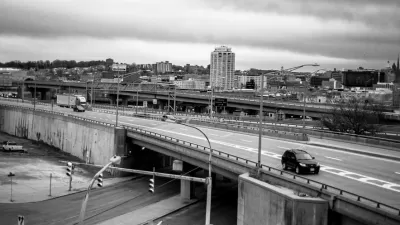A new report from the U.S. Public Interest Research Group PIRG's report estimates that road construction has cost the American public $600 billion since the highway system began.
Tanya Snyder at Streetsblog says the report shows that the traditional arguments that road construction "pays for itself", such as the economic benefit of cutting road congestion, don't hold water:
"Highway expansions are often justified as projects that relieve traffic and, believe it or not, reduce pollution. So if a highway widening achieved its stated aims, it would cut congestion and fuel consumption, which would mean fewer gas tax dollars and roads that don't pay for even a fraction of their construction costs. However, we know that new highway capacity doesn't actually reduce driving – it induces more driving.
The additional traffic created by expanding highways does generate more gas tax revenue, but still not enough to come close to covering the costs of new roads."
Thanks to Tanya Snyder
FULL STORY: Actually, Highway Builders, Roads Don't Pay For Themselves

Manufactured Crisis: Losing the Nation’s Largest Source of Unsubsidized Affordable Housing
Manufactured housing communities have long been an affordable housing option for millions of people living in the U.S., but that affordability is disappearing rapidly. How did we get here?

Americans May Be Stuck — But Why?
Americans are moving a lot less than they once did, and that is a problem. While Yoni Applebaum, in his highly-publicized article Stuck, gets the reasons badly wrong, it's still important to ask: why are we moving so much less than before?

Using Old Oil and Gas Wells for Green Energy Storage
Penn State researchers have found that repurposing abandoned oil and gas wells for geothermal-assisted compressed-air energy storage can boost efficiency, reduce environmental risks, and support clean energy and job transitions.

Greening Oakland’s School Grounds
With help from community partners like the Trust for Public Land, Oakland Unified School District is turning barren, asphalt-covered schoolyards into vibrant, green spaces that support outdoor learning, play, and student well-being.

California Governor Suspends CEQA Reviews for Utilities in Fire Areas
Utility restoration efforts in areas affected by the January wildfires in Los Angeles will be exempt from environmental regulations to speed up the rebuilding of essential infrastructure.

Native American Communities Prepare to Lead on Environmental Stewardship
In the face of federal threats to public lands and conservation efforts, indigenous groups continue to model nature-centered conservation efforts.
Urban Design for Planners 1: Software Tools
This six-course series explores essential urban design concepts using open source software and equips planners with the tools they need to participate fully in the urban design process.
Planning for Universal Design
Learn the tools for implementing Universal Design in planning regulations.
Heyer Gruel & Associates PA
City of Moreno Valley
Institute for Housing and Urban Development Studies (IHS)
City of Grandview
Harvard GSD Executive Education
Salt Lake City
NYU Wagner Graduate School of Public Service
City of Cambridge, Maryland




























